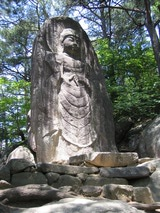
The carved image of the standing Buddha (마애불입상) on Gayasan, South Korea.
© Straitgate / Wikipedia Commons / Attribution-ShareAlike 3.0 Unported License
Buddhism in Korea has a long and distinguished history, but not always a smooth one.
Today Korea is divided, North and South. Secretive North Korea is officially an atheistic state, although there is a Korean Buddhist Federation that is part of the government. Buddhist clergy are, in effect, public employees Estimates of the number of Buddhists in North Korea range from 100,000 to just over one million.
South Korea is roughly 23 percent Mahayana Buddhist, 28 percent Christian, and about 46 percent of Koreans claim no religious affiliation. In recent years that has been considerable tension between South Korea’s Buddhists and fundamentalist Christians.
Early Buddhism in Korea (372-917)
Buddhism officially was introduced to Korea in 372 CE, while the Korean peninsula was divided into three kingdoms. A monk, an emissary from one of the several kingdoms in China, arrived with copies of sutras and Buddha images. It is suspected the Koreans already had some knowledge of Buddhism, however, through informal contact with other travelers.
Shamanism had been the primary religion of the Korean people before Buddhism and has remained part of Korea’s religious culture. Shamanism appears to have been blended into Buddhism soon after its introduction.
In the 6th century one of Korea’s three kingdoms, Silla, grew to become the dominant power of the Korean peninsula. Buddhism became the official religion of Silla during the reign of King Pophung (514-539). From then until late in the 8th century, many monks from Korea traveled to China to study and bring teachings back home.
One of these monks was Wonhyo (617-686), one of the most influential monks and scholars of all of Korean history. His extensive writing was influential in China and Japan as well as Korea.
Wonhyo was particularly interested in doctrinal coherence, and he surveyed the schools that had been transmitted to Korea by then, including Hyayan, Tiantai, Pure Land, and Ch’an (Zen). He systematically presented these diverse schools in a larger framework of Buddhist teaching to resolve their differences. The result is called Tongbulgyo or T’ong pulgyo, which means “interpenetrated Buddhism.”
Late in the 8th century Ch’an Buddhism, called Seon in Korea, became particularly prominent. Nine Seon monastic centers, called the Nine Mountains, were established.
A Golden Age (918-1392)
The Goryo Period was a time of political unity and stability in Korea, and Buddhism flourished, supported by the monarchy. Some consider this to be the golden age of Korean Buddhism.
The Korean Buddhist canon was published during this time. 81,000 of the woodblocks of this printing are stored at the Haein-sa on Mount Kaya, South Korea.
Prominent masters during this period included Jinul (1158-1210; also spelled Chinul) who is considered the founder of the Jogye order of Seon Buddhism, a dominant school in Korea today. Jinul was a reformer who integrated Hyayan teachings into Seon. He also encouraged meditation on koans.
As will happen with powerful institutions, toward the end of this period Buddhist institutions fell into corruption.
Persecution of Buddhism (1392-1910)
For the next five centuries, the Joseon Dynasty reigned in Korea and suppressed the practice of Buddhism. During this time Buddhist funerals and begging for alms were forbidden, and monks and nuns were restricted in their travels. Several thousand temples and monasteries were closed, and all schools but Seon Buddhism faded away in Korea.
Seosan Daesa (1520-1604) was a notable Seon master from this period. Seosan organized an army of warrior monks to repel a Japanese invasion of Korea that occurred between 1592 and 1598.He also made important contributions to the development of Seon. Most lineages of Seon in Korea today can be traced back to Seosan.
The Japanese Occupation (1910-1945)
Japan annexed Korea in 1910, which had the effect of ending the persecution of Buddhism. However, pressure was put on Korean monks to adapt to Japanese monastic practices. This included the ending of celibacy, since the Meiji Emperor had ended celibacy in Japanese Buddhismin the 19th century. The Japanese also insisted on loosening restrictions on wine and meat
.Some monks adapted; some did not. No Korean nuns accepted the Japanese adaptations, however.
In 1924 a new lay movement called Won Buddhism was established by Pak Chungbin ((1891-1943). Pak believed that the Buddhist teaching of Trikaya was represented, in one way or another, in all religions. Although Won’s doctrines are Buddhist, in organization and ceremonial observance it resembles Protestantism.
1945 to Today
Korea was liberated from Japan at the end of World War II, but almost immediately it was divided between North and South. Most religion is suppressed in North Korea, although the government-run Buddhist institution, the Korean Buddhist Federation, does survive.
South Korean monks almost immediately were thrown into a turmoil over celibacy. The dominant Jogye order of Seon Buddhism insisted in a return to full monastic rules, including celibacy. After much rancor and court battles, the married monks were turned out of the monasteries and properties restored to the celibate Jogye.
In recent years there also has been considerable friction between Korea’s Christian fundamentalists and Buddhists. The fundamentalists have even attacked several monasteries and destroyed Buddhist art. For more on this development, see “Christian-Buddhist Tension in South Korea.”